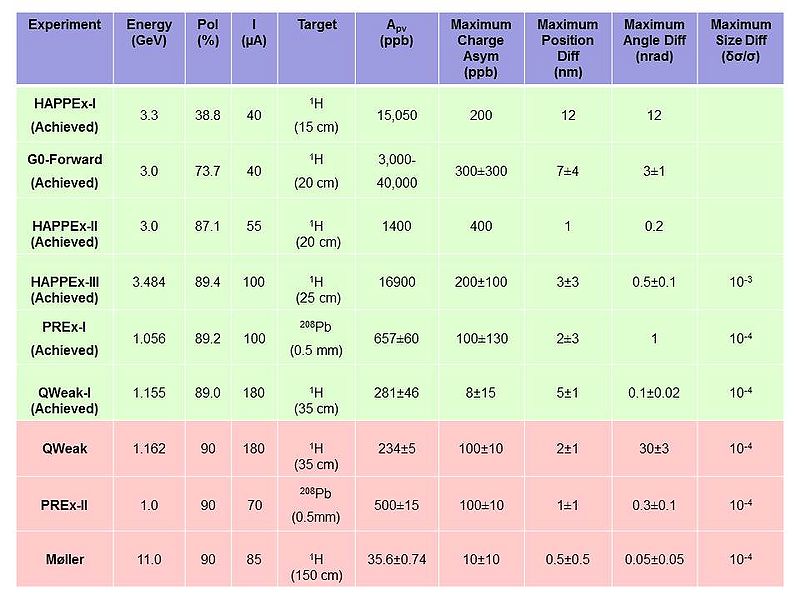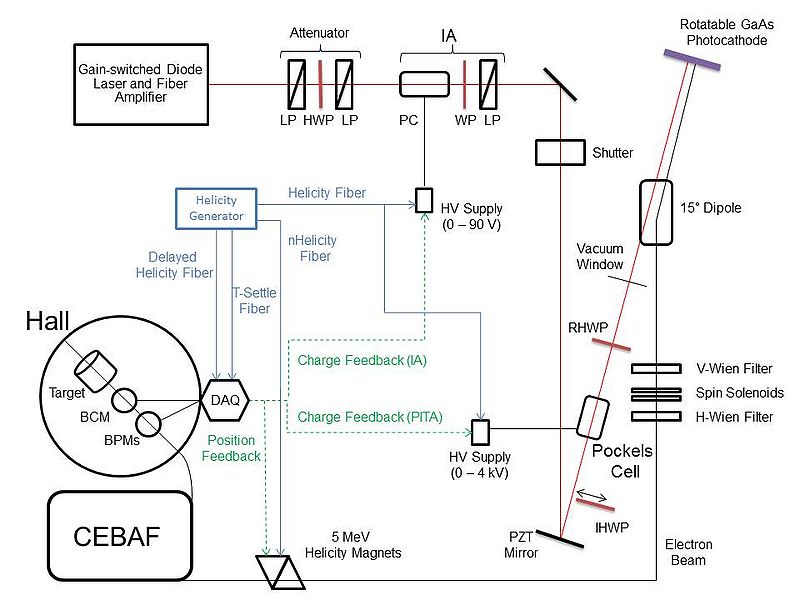Difference between revisions of "Parity Quality Beam"
| Line 201: | Line 201: | ||
* The pseudo-random 30-bit Shift Register | * The pseudo-random 30-bit Shift Register | ||
| − | # root macro is shown here (change .txt to .C): [[media:NewPseudoRanBitGenR.txt]] | + | # '''''root''''' macro is shown here (change .txt to .C): [[media:NewPseudoRanBitGenR.txt]] |
# c-code: | # c-code: | ||
Revision as of 14:28, 22 September 2014
A significant portion of the experiments performed at Jefferson Lab require a polarized electron beam. A subset of these are parity violation experiments which have exceptionally stringent requirements on the quality of the electron beam. As the sign of the electron beam helicity reverses at the target of the experiment no other measurable quantity of the electron beam may change. This includes the beam intensity, polarization, position, angle, energy or spot size.
To ensure this beam quality, a significant effort occurs at the polarized electron source, where the laser beam and electron photogun combine to produce the intended electron beam. Also significant is the ability to accelerate the beam to high energy while transporting it to the experimental target, all while maintaining a parity quality electron beam (PQB).
Parity Violation
Discussion of parity violation can be found at NIST: The Fall of Parity: [1]
Parity Violation Experiments
- JLab Hall A Parity Experiments (HAPPEx, PREx, C-REx, PVDIS): [2]
- JLab Hall C G0 Experiment: [3]
- JLab Hall C QWeak Experiment: [4]
- JLab Hall A Moller Experiment: [5]
- Mainz A4 Experiment: [6]
- The following table lists what has been achieved and the future requirements on PQB: media:jlab_parity_table.pdf media:jlab_parity_table.pptx
Selected References
- Experimental Test of Parity Conservation in Beta Decay. C. S. Wu et al., Phys. Rev. 105 (1957) 1413 media:PhysRev.105.1413.pdf
- Parity-Violating Electron Scattering and the Electric and Magnetic Strange Form Factors of the Nucleon. D. S. Armstrong and R. D. McKeown, Annu. Rev. Nucl. Part. 62 (2012) 337 media:annurev-nucl-102010-130419.pdf
Injector PQB Setup
- SLAC's polarized electron source laser system and minimization of electron beam helicity correlations for the E-158 parity violation experiment. T. B. Humensky et al., Nucl. Instr. and Meth. A 521 (2004) 261 media:NuclInstrMethA.521.261.pdf
- Helicity correlated asymmetries caused by optical imperfections. K. Aulenbacher, Euro. Phys. J. A 32 (2007) 543 media:EuroPhysJA.32.543.pdf
Moller PQB
- Moller Beam Requirements: media:Moller.Beam.Requirements.pdf
QWeak PQB
Accelerator Meetings
- Accelerator PQB Meeting August 13, 2009: media:PQB_Meeting_13Aug09.pdf media:PQB_Meeting_13Aug09.pptx
- Accelerator PQB Meeting June 2, 2009: media:PQB_Meeting_fHelReversal_02June09.pdf media:PQB_Meeting_fHelReversal_02June09.pptx
- Accelerator PQB Meeting June 2, 2009: media:PQB_Meeting_StatAna_02June09.pdf media:PQB_Meeting_StatAna_02June09.pptx
- Accelerator PQB Meeting May 19, 2009: media:PQB_Meeting_Ay_19May09.pdf media:PQB_Meeting_Ay_19May09.pptx
- Accelerator PQB Meeting April 28, 2009: media:PQB_Meeting_rtfeedback_28April09.pdf media:PQB_Meeting_rtfeedback_28April09.pptx
- Accelerator PQB Meeting April 7, 2009: media:PQB_Meeting_07April09.pdf media:PQB_Meeting_07April09.pptx
- Accelerator PQB Meeting March 24, 2009: media:PQB_Meeting_24March09.pdf media:PQB_Meeting_24March09.pptx
- Accelerator PQB Meeting March 5, 2009: media:PQB_Meeting_05March09.pdf media:PQB_Meeting_05March09.pptx
- Accelerator PQB Meeting February 17, 2009: media:PQB_Meeting_17Feb09.pdf media:PQB_Meeting_17Feb09.pptx
- Accelerator PQB Meeting November 10, 2008: media:PQB_Meeting_10Nov08.pdf media:PQB_Meeting_10Nov08.pptx
- Accelerator PQB Meeting September 1, 2008: media:PQB_Meeting_01Sep08.pdf media:PQB_Meeting_01Sep08.pptx
B-Team Presentations
- B-Team PQB Presentation October 28, 2009: media:B-Team_PQB_28Oct09.pdf media:B-Team_PQB_28Oct09.ppt
- B-Team PQB Presentation May 13, 2009: media:B-Team_PSSNoise_13May09.pdf media:B-Team_PSSNoise_13May09.ppt
- B-Team PQB Presentation April 29, 2009: media:B-Team_PQB_29April09.pdf media:B-Team_PQB_29April09.ppt
- B-Team PQB Presentation December 3, 2008: media:B-Team_PQB_03Dec08.pdf media:B-Team_PQB_03Dec08.ppt
- B-Team PQB Presentation October 9, 2008: media:B-Team_PQB_09Oct08.pdf media:B-Team_PQB_09Oct08.ppt
Collaboration Presentations
- QWeak Collaboration Meeting September 17, 2010: media:QWeak_Coll_17Sep10.pdf media:QWeak_Coll_17Sep10.pptx
- QWeak Collaboration Meeting May 24, 2010: media:QWeak_Coll_24May10.pdf media:QWeak_Coll_24May10.pptx
- QWeak Collaboration Meeting February 1, 2010: media:QWeak_Coll_01Feb10.pdf media:QWeak_Coll_01Feb10.pptx
- QWeak Collaboration Meeting February 1, 2010: media:QWeakInjTeam_01Feb10.pdf media:QWeakInjTeam_01Feb10.pptx
- QWeak Collaboration Meeting November 8, 2009: media:QWeak_Coll_08Nov09.pdf media:QWeak_Coll_08Nov09.pptx
- QWeak Collaboration Meeting November 8, 2009: media:QWeakInjTeam_08Nov09.pdf media:QWeakInjTeam_08Nov09.pptx
- QWeak Collaboration Meeting July 17, 2009: media:QWeak_Coll_17Jul09.pdf media:QWeak_Col_17Jul09.pptx
- QWeak Collaboration Meeting November 18, 2008: media:QWeak_Coll_18Nov08.pdf media:QWeak_Coll_18Nov08.pptx
Other Presentations
- CEBAF Ops Parity Training August 5, 2009: media:parity_Ops_Training_05Aug09.pdf media:parity_Ops_Training_05Aug09.pptx
- S&T Review July 14, 2009: media:S&T_Review_2009.pdf media:S&T_Review_2009.pptx
- PAVI09 June 22 2009: media:PAVI09_suleiman.pdf media:PAVI09_suleiman.ppt
Technical Developments
- QWeak Beam Requirements: media:Qweak.Beam.Requirements.pdf
- Discussion of technical developments in preparation for the QWeak experiment:
Jefferson Lab injector development for next generation parity violation experiments. J. Grames, J. Hansknect, M. Poelker, R. Suleiman, Hyperfine Interactions 201 (2011) 69 media:HyperfineInter.201.69.pdf
- Schematic of Jefferson Lab Injector setup: media:jlab_source_PV2.pdf media:jlab_source_PV2.pptx
Two-Wien Slow Helicity Reversal
- Two Wien Filter Spin Flipper. J. Grames et al., Part. Accel. Conference (PAC’11), New York, NY, (2011) media:tup025.pdf
New Helicity Board
- A new helicity board was built for the QWeak experiment: media:NewHelBoardDesign.pdf media:NewHelBoardDesign.pptx
- More details can be found in the User's Guide: media:Helicity_Board_UserGuide.pdf media:Helicity_Board_UserGuide.docx
- Helicity Board Configuration Quick Reference:
| Mode | T_Settle | T_Stable | Helicity Pattern | Reporting Delay | Helicity Board Frequency (Hz) | |
| Default (30 Hz) | Free Clock | 500 µs | 33330 µs | Quartet | 8 windows | 29.56 |
| 5 MeV Mott | Free Clock | 500 µs | 33330 µs | Quartet | No delay | 29.56 |
| Hall A Moller | Free Clock | 100 µs | 16667 µs | Quartet | 8 windows | 60.0 |
| Hall A Moller | Free Clock | 100 µs | 8233.35 µs | Quartet | 8 windows | 120.0 |
| PREx | Free Clock | 100 µs | 4066.65 µs | Octet | 16 windows | 240.0 |
| QWeak | Free Clock | 70 µs | 971.65 µs | Quartet | 8 windows | 960.0 |
- The pseudo-random 30-bit Shift Register
- root macro is shown here (change .txt to .C): media:NewPseudoRanBitGenR.txt
- c-code:
New Pockels Cell HV Switch
- A simple and inexpensive high voltage switch for driving Pockels cells and other low capacitance loads: media:Pockelsswitchposter.pdf media:Pockelsswitchposter.pptx
Electronic Cross-talk & Ground Loop Elimination
- Electronic Cross-talk & Ground Loop Elimination in Injector: media:jlab_source_GroundLoop.pdf media:jlab_source_GroundLoop.pptx
Helicity Magnets Control Upgrade
- On January 4, 2012, the power supply cards were modified to reduce the slopes during QWeak. Added 220 milli-ohm resistor in parallel with each channel of magnet and series load resistors (approx 3.8 ohms). Current through a given magnet should now be 2.5 - 3% of the total amplifier output current.
- Details of the plan to upgrade the controls of the Helicity Magnets (to be completed before Moller experiment): media:HMUpgrade_plan_27Dec11.pdf media:HMUpgrade_plan_27Dec11.pptx
G0 PQB
Lessons Learned
Lessons learned for parity violation experiments at Jefferson Laboratory is an on-going series of meetings between scientists and students from the accelerator and physics division to learn from past experiences and meet new challenges in the field of parity violation experiments:
- Supperlattice SVT4722#2 in Gun3, January 2005:
- Riad's G0 beam studies summary to the MCC 8 AM meeting on February 1, 2005: media:svt4722-2_8am_050201.ppt
- Parity Beam Quality Specifications:
- Specifications for Beam Parameters for HAPPEX-II and HAPPEX-He from the HAPPEX Collaboration: media:HAPPEX_Beam_Requirements.ps
- Beam Parameter Specifications for the G0 Experiment from the G0 Collaboration: media:g0_beamspec.ps
- Preliminary Beam Specification Parameters for the Qweak Experiment from Roger Carlini: media:Qweak_Beam_Parameters_Prem.pdf media:Qweak_Beam_Parameters_Prem.doc
- Lessons Learned Part 1 November 18, 2004 - Meeting minutes are here: media:LessonsLearned_18Nov2004.pdf media:LessonsLearned_18Nov2004.docx
- Phase Trombone for HAPPEX-2 from Alex: media:Phase_Tromb_HAPPEX_2004.pdf
- Parity Lessons Learned from Chao: media:Parity_Lessons_Learned_chao_2004.pdf
- Parity Quality Beam Development and Experiment Timeline from Matt: media:Parity_Exp_Timeline_Poelker_2004.doc
- Aligning the Pockels cell - the HAPPEX procedure: media:Aligning_the_pockels_cell_2004.doc
- Comments about Helicity Effects for G0 and HAPPEX from Mark: media:pitt_parity_lessons_learned_meeting_2004.pdf media:pitt_parity_lessons_learned_meeting_2004.ppt
- Injector Setup for G0 and HAPPEX from Reza: media:lessons_learned_G0_and_HAPPEx_reza_2004.ppt
- Lessons Learned Part 2 December 9, 2004 - Meeting minutes are here: media:LessonsLearned_9Dec04.doc
- G0 slide regarding beam loading from Kaz: media:beam_loading_kaz_2004.pdf media:beam_loading_kaz_2004.ppt
- Augmented version of slides from Mark for Part 1 meeting: media:pitt_parity_lessons_learned_meeting_dec_09_04.pdf media:pitt_parity_lessons_learned_meeting_dec_09_04.ppt
- HAPPEX presentation from Kent: media:HAPPEX_LessonsLearned_kent_2004.pdf media:HAPPEX_LessonsLearned_kent_2004.ppt
- Here is Chao's report on recent beam studies: media:Parity_meeting_120904_chao.pdf
- Lessons Learned Part 3 January 13, 2005:
- Matt's meeting outline: media:Parity_Tests 1_05_matt.doc
- Chao showed injector matching results from December: media:Test_Result_122004_chao.pdf
- Riad's summary of Injector Studies Using Superlattice Photocathode, January 13, 2005: media:inj_studies_011005_riad.ppt
G0 Backward Angle Run 2006
- G0 Accelerator Planning Meeting, November 1, 2005:
- Introduction & Proposed Beam Specifications, Grames: media:G0Planning_051101_grames.ppt
- Beam Halo Considerations (from Beam Specs document), Pitt: media:beam_halo_pitt_051101.ppt
- Beam Halo Forward Angle Example, Pitt: media:g0_halo_profile_pitt_051101.pdf
- Proposed Accelerator Configuration, Freyberger: media:G0_prep_freyberger_051101.pdf
- Source & Beam Issues, Suleiman: media:G0_acc_suleiman_051101.ppt
- Injector Matching, Chao: media:G0_Preparation_chao_051101.pdf
- Engineering Issues, Lauze: media:EEConcerns_lauze_051101.doc
- Beam Parameter Specifications for G0 Backward Angle Run October 7, 2005: media:g0_beamspec_back_angle.pdf
- Summary of Pockels Cell Studies:
- Presentation in January 2006: media:pc_install_beam_studies_jan_2006.pdf media:pc_install_beam_studies_jan_2006.ppt
- Presentation in March 2006: media:pc_install_beam_studies_march_2006.pdf media:pc_install_beam_studies_march_2006.ppt
- Presentation in July 2006: media:pc_install_beam_studies_july_2006.pdf media:pc_install_beam_studies_july_2006.ppt
- Presentation in September 2006: media:pc_install_beam_studies_sept_2006.pdf media:pc_install_beam_studies_sept_2006.ppt
- Presentation in January 2007: media:pc_install_beam_studies_jan_2007.pdf media:pc_install_beam_studies_jan_2007.ppt
Other Presentations and Tech Notes
- FAQ for Injector Matching. Yu-Chiu Chao, 2008: media:JLabTechNote.08-040.pdf
- Collection of Notes Related to Future Work on Parity Quality Beam. Yu-Chiu Chao, 2008: media:JLabTechNote.08-039.pdf
- Phase Trombone for Parity Experiments. Alex Bogacz, 2007: media:JLabTechNote.07-039.pdf
- HAPPEx III Beam Requirements: media:HAPPEx.III.Beam.Requirements.pdf
- HAPPEx Collaboration Meeting May 18, 2007: media:happex_may_2007.pdf media:happex_may_2007.ppt
- Helicity Magnets Commissioning, MCC Talk, February 7, 2007: media:HelMag_Comm_MCC_talk_07Feb07.pdf media:HelMag_Comm_MCC_talk_07Feb07.pptx
- The G0 Experiment: Backangle Running. Jefferson Lab Accelerator Seimnar, Riad Suleiman, Virginia Tech, November 2, 2006: media:G0_Acc_Seminar_suleiman_02Nov06.pdf
- G0 Adiabatic Damping, Marck Pitt: media:G0_AdiabaticDamping_pitt.pdf media:G0_AdiabaticDamping_pitt.pptx
- Parity Violation Experiments at CEBAF Beam Specifications, Matt Poelker, March 4, 2004: media:parity_table_2004.ppt
- Target Density Fluctuations and Bulk Boiling in the Hall A Cryotarget. D.S. Armstrong, B. Moffit, and R. Suleiman: media:JLabTechNote.03-017.pdf
- G0 Collaboration Meeting August 16, 2002: media:g0_collab_aug16_2002.pdf
To-do List
- Include G0 Pockels Cell Alignment Procedure
- Add the root macro and c-code for the 30-bit register
- Add the root macro that illustrate charge feedback
- Write the helicity board NIM paper: media:Helicity_NIMA_draft1.pdf media:Helicity_NIMA_draft1.docx


